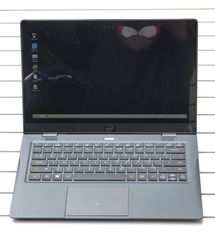 Harris Beach Developer Ultrabook unboxing and first impressions
Harris Beach Developer Ultrabook unboxing and first impressions
Harris Beach is the name of the latest developer edition of the Intel Ultrabook. You can’t buy this in the shops because it has been designed by Intel for software developments and experimentation. It contains some of the newest technologies you’ll find in any laptop (or even PC) and is packed with as many features as possible. NGFF SSD, NFC, GNSS, HSPA+ 3G modem (21Mbps), Panel Self Refresh, HD 5000 graphics, Full HD IPS screen and of course a Haswell U-Series processor which is incredibly efficient.
Unlike the last developer-edition Ultrabook, created for the launch of Ivy Bridge, this product is in a different league. It’s slicker, it feels like it uses higher quality components and materials and it looks great. I think the casing is plastic but it’s incredibly solid and feels good to the touch. I wonder if this is Intel’s new low-cost plastic casing. If it is, it gets my thumbs-up.
Not only is Harris Beach a product that looks and acts like a great Ultrabook, it’s got the packaging to match. Here’s the unboxing. Watch out for the surprise as the lid is lifted!
I’ve had a few days to familiarize myself with Mr Harris Beach and I’ve also had a chance to run some performance tests. I’m not going to go into those before I’ve determined the status of the drivers and Windows 8 build on the device but I can tell you that it’s very, very impressive so far. In terms of battery life there’s nothing more that needs to be done because 9hrs web working is possible. (53Wh battery inside.) I’m also impressed with the 21Mbps HSPA+ (GSM 3G) performance and the screen is a stunner. [Note: I’ve already tested two Haswell-based Ultrabooks so I have a good baseline.]
Here are a few specs for you..
- CPU Core i5 4th generation. 1.4Ghz (Turbo max to 2.9Ghz) VPro capable.
- GPU HD5000 graphics with max clock 1.1Ghz.
- Intel 530 series NGFF SSD (Max transfer rates seen so far: 400MBps read. 256MBps sequential. 28MBps / 73MBps r/w 4K block size.)
- Huawei HSPA+ / GNSS
- Windows 8 Pro (requires MSDN key to enable.)
Other features:
- Keyboard backlight
- TPM 2.0
- HID Sensor set
- Dual array mic as per Haswell Ultrabook standard.
- WiDi
WiFi performance isn’t up to what I expect from a business-class device but the focus here is to enable developers to do their stuff, not for enabling business. The 2.4Ghz WiFi is adequate (Update: 5Ghz band also supported and tested) and Connected-Standby approved. CS {AKA InstantGo, AOAC) works. This is a unique and important feature for devs (who can find out more here.)
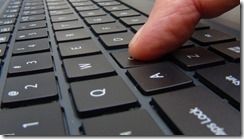
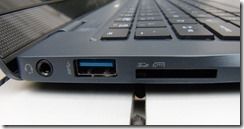
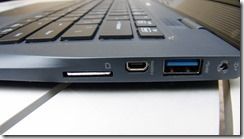
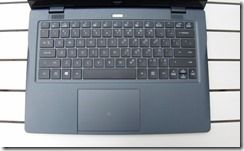
Full gallery of Harris Beach developer Ultrabook.
The fans aren’t the quietest either but there’s the challenge for devs – build an app that doesn’t trigger the fans!
Drivers, Code and Dongles
In the box you’ll find important notes and, behind those, a set of cables. Micro HDMI to VGA, Micro HDMI to HDMI and USB3.0 to RJ45 (Gigabit Ethernet.) It’s a shame there’s no DisplayPort though as that’s an enhanced feature of Haswell and it’s 4K / DP1.2 capability. You’ll also find a slick and light power adaptor. I wish manufacturers would all follow this lead. (No pun intended.)
All the drivers (for the pre-installed build) are provided on a USB stick and it looks like a recovery partition is also available. The status of that build, however, is unknown. Latest drivers are available to developers that are registered for Intel Premier Support.
In addition to providing documentation, drivers and support, Intel have taken the chance to include, on the desktop, links to code samples that demonstrate various Ultrabook features. I haven’t had time to install these apps yet but here’s the list of what’s included:
- Touch Terrain – Using touch to deform terrain.
- Real-Time Strategy – A Game demo that uses multiple input methods.
- Windows 8 Touch Coding Demo – Windows 8 desktop code.
- Sensors Demo – Accessing Windows 8 (dekstop) sensors
- Windows 8 desktop rotation – Detect screen orientation changes in desktop applications.
- Sensor Explorer – How to register and receive sensor information from a Windows 8 desktop app.
- Light Scattering – GPU capability demo.
- Software Occlusion Culling – This probably means something to graphics people; Not me though!
- Head-Coupled Perpective – Head tracking using the webcam and perceptual computing SDK.
- Intel Power Gadget – Shows real-time Haswell package power usage, TDP and other information.
- Intel Smart Connect Monitor – Detect and respond to power transitions in an application.
- SIMD Instructions in Windows 8 Store apps – SIMD can boost performance in Windows 8 apps. SIMD library.
That’s a great set of demos for developers.
Other notes
- Speakers: Stereo and good quality.
- Keyboard: Good to very good (still under test.)
- Mousepad: Good to very good. NFC integrated. (still under test)
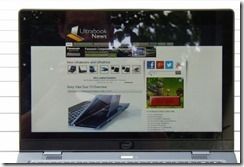 Screen brightness very good. (see image right which is a good likeness of what my eyes were seeing in very bright daylight.)
Screen brightness very good. (see image right which is a good likeness of what my eyes were seeing in very bright daylight.)- Weight: 1466 grams. (3.23 pounds.)
- No battery life indication. (Connected Standby devices do not give an indication of battery life, only of battery capacity remaining like a smartphone would. The range of battery life for a Haswell Ultrabook ranges between weeks and hours (gaming being the most demanding scenario) depending on usage so that’s understandable but there’s scope for projected battery life based on current usage and past Windows 8 usage battery life and it would be nice to see that. (App opportunity?) There is also no concept of power profiles. These are controlled and instigated by the system when needed. (In different heat scenarios, usage scenarios or, in the case of detachables and convertibles, usage scenarios.)
Summary.
Developers need stimulation and Harris Beach is perfect for that. There’s so much power here, so much dynamic range, so many features and a lot of great software and support. The whole package even looks great which is rare for a development kit. Sure, a detachable Ultrabook based on Y-series Haswell processors would have been nice but it’s too early for that. Harris Beach is good as it is. In fact, the whole product, including packaging, looks so good that I wonder if Intel are planning more than just ‘behind-the-scenes’ usage. It looks to me like Harris Beach could be a very public development product and by that I mean look out for appearances at the Intel Developers Forum in Sept. Dare I say, free for attendees? That would a great step. (IDF 2013 San Francisco registration here if you believe my speculation.)
Full gallery of Harris Beach developer Ultrabook.
How to get Harris Beach. We’ll bring you contact information as soon as we can. Please be aware that this is a development kit and its use will require contracts with Intel.
Our Ultrabook developer resources, with more code samples, demos and lots more information can be found here: Ultrabook Software Development Resources.
See all our Harris Beach articles, including the latest articles when posted.
Full disclosure – The hardware for content related to Harris Beach has been provide by Intel. We have agreed to write a set of 3 articles on the product. All posts are 100% written and edited by Ultrabooknews.











Looks pretty nice for a dev kit. Wonder if the broadcom modem also has the problems with connectivity as some have had on the Duo 13.
The Broadcom modem is 2.4Ghz and reception is relatively weak but perhaps acceptable for a developer that may not be too mobile and that can set this Ultrabook up as a desktop with the included Ethernet adaptor.
We’re going to have to keep a close eye on this Broadcom module and the antenna design around it. No 5Ghz is a problem for many these days too.
From another review:
4GB of RAM, 128GB SSD […] and fan that’s irritating in a quiet room.
Add a glossy screen: it’s a no-buy.
It truly is a no-buy. This is not a consumer Ultrabook.
not for consumers, not for developers
How much ram?
4GB.
Too bad about the crappy WiFi but I guess being CS capable is more important for developers. No working at the cafe, airport and other places. I doubt devs would want to spend their mobile data downloading stuff from code repos. That is if they’re not working for a company that would pay for it.
Still, is this Broadcomm chip the only available one? CS capable Clover Trail devices at least have a dual band chip.
Which Clovertrail devices have you seen with dual-band? I have two here with the Broadcom 2.4Ghz solution.
My Dell Latitude 10 connects to my 5 GHz SSID just fine. I have separate SSIDs for 2.4 GHz and 5 GHz. It has a Dell rebranded Broadcom WLAN + Bluetooth chip. It only has a single antenna so it’s not very robust which becomes very apparent during long transfers (voice/video chats, video/audio streaming, LAN file transfers, etc.). I haven’t checked what the Broadcom model number is.
Some reviews say the Samsung ATIV 500T is dual band. Same for reviews of the Acer W510.
I know you have a W510. Maybe there’s something up with your setup? Maybe this ultrabook really is dual band, albeit an unstable 1×1 antenna design.
Interesting. I will check W510 and 500T again as I have them here.
I’ve made a mistake. The Harris Beach Ultrabook *does support 5Ghz band* I’m connected now (802.11n). (My problem is that my 5Ghz hotspot is a little further away and was dropping back to the 2.4Ghz hotspot as I tested.) I will now go and re-test the two Clovertrail devices I have here and prepare a correction.
My apologies for this mistake. I will correct the article above now.
Interesting that the Broadcom adapter properties suggest that diversity antennas are possible. I will look closer into this.
I guess you have a big house. 5 GHz signals not being able to travel far or through walls as well as 2.4 GHz signals are both good (less interference) and bad (less distance).
I have antenna diversity options too but I definitely have a 1×1 configuration. There are also 40 MHz bandwidth options but I never get a link greater than 65 Mbps which is the max for 20 MHz bandwidth. My notebook with an Intel 6300 WiFi chip gets a 450 Mbps link fine (3 streams and a 40 MHz channel).
Does that mean no WiDi? I’ve heard Intel has approved certain Broadcom chips for WiDi…
I haven’t heard much about WiDi lately, but I’d like it. I heard a rumor on notebookreview.com that Intel would only allow Intel wireless with supported WiDi to receive the “Haswell Ultrabook” label.